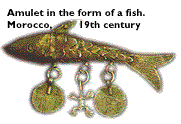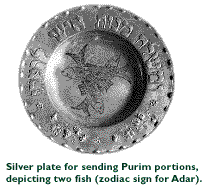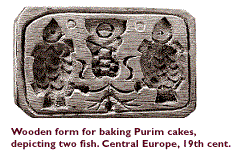|


 In
the Jewish tradition, as in the Christian, fish are symbolic of fertility and
abundance. They thus appear on a wide variety of Judaica objects and manuscripts.
The prevalence of the fish symbol on illustrated ketubbot (wedding manuscripts)
and on amulets for barren women is quite obvious. In
the Jewish tradition, as in the Christian, fish are symbolic of fertility and
abundance. They thus appear on a wide variety of Judaica objects and manuscripts.
The prevalence of the fish symbol on illustrated ketubbot (wedding manuscripts)
and on amulets for barren women is quite obvious.
Many spice boxes, used in the Havdalah ceremony which bids goodbye to
the Sabbath on Saturday evening, are shaped like fish. The Havdalah ceremony
closes with the words, "May He who separates between the sacred and the
everyday, forgive our sins and cause our children and our money to multiply
like the sand"; the use of the fish as a symbol of abundance is thus understandable
in this context.
 There
is a strong association between fishes and the festival of Purim. The fish sign
is found also on Adar tablets called Misheniknas, from the initial word
of the expression: Misheniknas Adar marbim b'simcha — When the month
of Adar begins, we make plenty of merry.[*].
These paper wall tablets, used chiefly in Galicia, are decorated with picures
of drinking men, wine bottles, and two symbols of fertility — fishes and
the stork. There
is a strong association between fishes and the festival of Purim. The fish sign
is found also on Adar tablets called Misheniknas, from the initial word
of the expression: Misheniknas Adar marbim b'simcha — When the month
of Adar begins, we make plenty of merry.[*].
These paper wall tablets, used chiefly in Galicia, are decorated with picures
of drinking men, wine bottles, and two symbols of fertility — fishes and
the stork.
 Plates
for sending food gifts (mishloah manot) on Purim and even the forms themselves
for baking Purim cakes, often used the shape of a fish. In addition to its association
with plenty (because of the corresponding verse "in Adar we make plenty
of merry"), the fish symbolizes the month itself, whose zodiac sign is
Pisces. Plates
for sending food gifts (mishloah manot) on Purim and even the forms themselves
for baking Purim cakes, often used the shape of a fish. In addition to its association
with plenty (because of the corresponding verse "in Adar we make plenty
of merry"), the fish symbolizes the month itself, whose zodiac sign is
Pisces.
|
[*] Babylonian Talmud,
Ta'anit 9a [back] |
FISH Table of Contents
|